GROUNDNUT production is one of the major economic activities smallholder farmers in the eastern region of Zambia engage in.
The Department of Agriculture in Eastern Province says that groundnuts constitute the second, most widely grown crop after the staple crop, maize.
Smallholder farmers in the province engage in seasonal groundnut production to ensure food security and financial gain for their households.
The crop is equally important in Zambian diets because of its high nutritional value.
However, cultivation of groundnuts does not come without limitations.
For instance, groundnuts are vulnerable to aflatoxin contamination, a fungi-produced toxin that resides in the soil and affects crops.
Research has shown that aflatoxin thrives in humid conditions and is prevalent in such staple crops as groundnuts and maize.
Groundnuts are said to be particularly susceptible to infection following prolonged exposure to a high-humidity environment, or damage from stressful conditions such as drought.
The fungi which cause Aflatoxin can contaminate groundnuts before harvest, during storage or even during preparation of the crop for the market, especially when farmers sprinkle water on the crop so as to ease shelling.
If not mitigated, therefore, aflatoxin reduces groundnut yields and threatens exports. This consequently affects household incomes of smallholder farmers.
It is also fatal to humans as it has been known to cause liver cancer and stuntedness in children, among other illnesses.
Against this backdrop, the International Crops Research Institute for the Semi-Arid Tropics (ICRISAT), working in collaboration with the ministry of Agriculture and Livestock through the Zambia Agriculture Research Institute (ZARI), has for the last three years been strengthening efforts through implementation of strategic projects to reduce incidences of aflatoxin in groundnuts in Eastern Province.
One such project is the ‘Aflatoxin Mitigation in Groundnuts’ project which has been implemented in Eastern Province since 2012 and is aimed at abating Aflatoxin and increasing yields of smallholder farmers.
In this project, ICRISAT, working with the Zambian Government through Msekera Research Station in Chipata, targets smallholder farmers whom it equips, through training, with the knowledge on how to mitigate Aflatoxin in groundnuts so as to maximise yields and household incomes.
ICRISAT’s quality control officer Joseph Maruwo said that farmers themselves conducted trials in their fields so that they could be able to determine the best growing conditions for groundnuts.
“We give farmers some seed so that they can do three different trials in their fields. The trials focus on time of planting, land preparation and water management. This is to ensure that farmers determine the best farming practices to employ in their groundnut fields,” Mr Maruwo said. -NAIS







